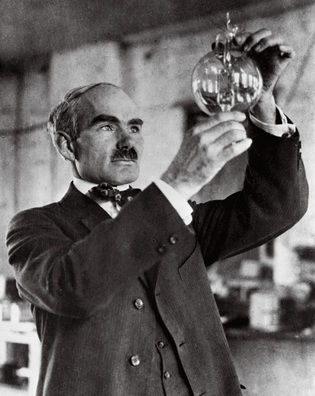 loading
loading
Old YaleThe man who invented radioInventor Lee De Forest 1896, ’99PhD.  Bettman/CorbisRadio, movie, and TV pioneer Lee De Forest at work in the laboratory on one of his many inventions. View full imageIn 1924, Lee De Forest (1873–1961) returned to his alma mater to speak about his new invention, "talking movies." De Forest, who had graduated from Yale's Sheffield Scientific School in 1896 and received his Yale doctorate in 1899, recalled a lecture he had attended as a student that was given by Alexander Wurts (Sheffield 1883). Wurts's description of his invention of the lightning arrester (an early form of surge protector) had inspired De Forest to enter the field of experimental research. He told his audience that he had vowed, if he became successful, to return to Yale to lecture on his own work. He hoped, he said, to "plant the seed of inventive ambition in a student of today." At Yale, Lee worked as a waiter, caretaker, and research assistant to pay for his room and board. During his senior year, his father, Henry Swift De Forest, Class of 1857, ’66BDiv, died suddenly. His mother moved to New Haven so that Lee and his brother Charles, Class of 1901, could afford to attend Yale. The De Forest men had also benefited from a scholarship. The money came from the David de Forest Scholarship Fund, established by a distant relative, which gave first preference to descendants of his bearing the exact family name. So while at Yale the brothers, as a courtesy, spelled their name with the lowercase "d." In graduate school, De Forest's mentor was Josiah Willard Gibbs ’58, ’63PhD, the world-famous theoretical physicist and mathematician. In De Forest's autobiography, Father of Radio, he praised Gibbs's "colossal mind" and wrote, "Thanks to the deep inspiration I was deriving from Gibbs, I well knew that the leaders in electrical development would be those who pursued the higher theory of waves and oscillations and the transmission by these means of intelligence and power. " De Forest's dissertation on the reflection of Hertzian waves at the ends of parallel wires was published in the American Journal of Science in 1899. He worked on developing the wireless telegraph, and in 1906 invented the Audion, a three-electrode vacuum tube. In a 1990 New York Times article, "Out of De Forest and Onto the Air Came Music," Hans Fantel called De Forest's invention, the standard radio tube, "the first effective device for electrical amplification." At first the world was not impressed. De Forest worked for the U.S. Navy, building wireless telegraph devices, while he planned spectacular schemes for publicizing the possibilities of radio broadcasting. In 1908, for the French War Office, he successfully demonstrated his system of wireless telephony from the Eiffel Tower. Then, on January 13, 1910, using a fishing pole as an antenna, he broadcast the first "Live from the Met" performance, featuring Enrico Caruso in Cavalleria Rusticana and Pagliacci. Of course, no one yet had a radio, so public receivers were set up in New York City, Jersey City, and Bridgeport, Connecticut. Radio broadcasting developed slowly. The first major use of the Audion was by AT&T; the company acquired rights in 1913 to inaugurate coast-to-coast long-distance service using the Audion as an amplifier. In November 1916, De Forest broadcast the first U.S. presidential election report. During World War I, he developed radio, telephone, and telegraph devices for field and airplane communications for America and the Allies. (De Forest received more than 180 patents, but he spent a considerable amount of time and money in court defending his claims to his inventions, including the Audion.) After the war, in 1919, he patented a sound-on-film process. Most attempts at making "talking" pictures involved playing recordings of dialogue, music, and other sounds that matched the action on screen. (The first popular "talkie," Al Jolson's 1927 The Jazz Singer, worked essentially that way.) But the De Forest Phonofilm process embedded the sound track into the film. More than 200 short movies were created with it, including, in 1924, a six-minute speech by New York governor Alfred E. Smith for his presidential nomination campaign -- the first application of a sound movie to politics. De Forest's Phonofilm technology was soon eclipsed by rivals. Still, in 1959, the Academy of Motion Picture Arts and Sciences awarded him an honorary Oscar for "his Pioneer Invention which brought Sound to the Motion Picture." In 1931 De Forest turned his attention to television, then in its infancy. His first invention in this area was the "tele-film," a method of television for full-screen theater projection. When De Forest demonstrated it at the MGM studio theater, Louis B. Mayer said, "So what?" This proved prophetic, for the Great Depression would take its toll, and the project folded. Even so, when he was honored on the classic TV show This is Your Life in 1957, De Forest was introduced as the "Father of Radio and the Grandfather of Television." At his 30th college reunion in 1926, Yale awarded De Forest an honorary Doctor of Science degree. The citation read in part: "Dr. De Forest is one of the foremost magicians in the romantic domain of modern science; he has helped to make the present age preeminently the age of miracles."
The comment period has expired.
|
|